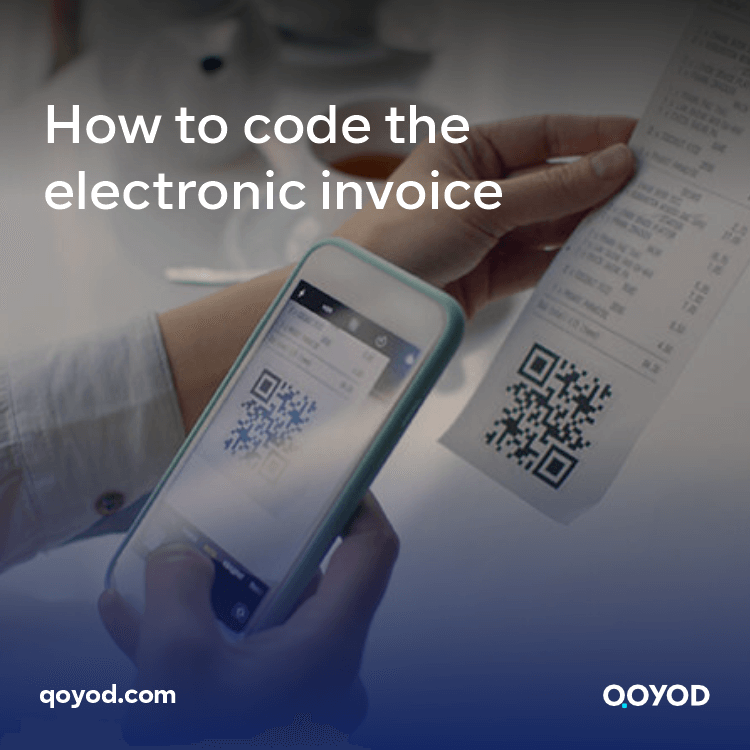In a world of technology and rapid progress, our transition from paper and pen to the digital world has become inevitable, and there is no doubt that one of the most amazing and interesting transformations is the evolution of the electronic invoicing system, as heavy papers turn into vibrant digital codes. What if I told you that you are now able to store countless varieties of products in the palm of your hand? The key to magic is to code the electronic invoice! It turns each product into just a set of numbers and letters that give it a unique and distinctive identity. It should be noted that, thanks to them, access to information is no longer limited to the few, and clients now have access to accurate information about the goods they purchase with a single touch on their smartphone screen. Wow!
What is electronic invoice coding?
It is the process of converting information related to items, quantities, and prices in the invoice into specific standard codes, and the coding process is carried out through the use of a system based on unified rules and standards. It is worth noting that the coding of items provides accuracy and a common understanding of information in the invoice, facilitates the process of monitoring and controlling inventory, and improves the efficiency of business operations.
Why is the electronic invoice coded?
Among the main points that make the coding of the electronic invoice necessary and important, the following can be mentioned:
Ensure accuracy and compatibility.
The item codes in the electronic invoice help ensure the accuracy of the information circulating between different parties. When the information is converted into specific codes, it becomes easy to accurately identify items, avoid possible human errors in data entry, and help ensure compatibility between different electronic invoicing systems and exchange information smoothly and effectively.
Reduce fraud and manipulation.
With the coding of the electronic invoice, the chances of fraud and manipulation of commercial data are reduced, as items are clearly identified and unique codes are assigned to each item, thus helping to reduce the chances of price adjustments or illegal changes of items and protecting the parties involved in the business process.
Ease of control and monitoring
Electronic bill codes assist in the control and monitoring process by the relevant government authorities, including the tax authority. Thanks to the standard codes used in the billing, stakeholders can easily analyze data and compare it with other records, thus facilitating checks and monitoring of taxes and commercial transactions.
Facilitating financial transactions
Electronic invoice coding allows for easy collection and payment processes, as electronic invoices can be sent quickly and easily via e-mail or e-commerce platforms, which reduces delays and errors that may occur in the traditional process.
Note
When companies use e-invoicing, they can achieve many benefits, including reducing costs, increasing efficiency, and speeding up collections. However, converting traditional invoices into a certain electronic format requires a clear and efficient coding process.
Item Coding Standards
Item coding is the process of converting information about products and items into standard codes, and there are many standards used to code items, most notably:
GS1 Codes
GS1 is one of the most common and commonly used standards in item coding, applied on a global level, and is managed by the World Marketing Organization (GS1).
Information on GS1
GS1 uses globally known barcode codes, such as GTIN and GTIN. (GLN). Among others, it should be noted that GS1 maintains a global database for the identification of codes, ensuring compatibility and common understanding of items across the world.
What does the GS1 bill code include?
The GS1 code contains information such as: manufacturer, country of origin, product identifier, plus quantity package, etc.
EGS Standard
It is another standard used in item coding; this standard is managed by EPCglobal and is an evolution of the GS1 standard. EGS uses RFID (Radio Frequency Identification) technology, which includes small chips in products that carry unique identifying information.
About the EGS standard
This information is read using RFID readers, and EGS coding includes information similar to the GS1 standard, such as product ID, manufacturer, etc., but carried on an RFID chip instead of barcode codes.
What do you use these criteria for?
The GS1 and EGS standards provide a common basis for the compilation of items and the exchange of information between different parties in the supply chain, and it should be noted that these standards enhance transparency, efficiency, and accuracy in dealing with items and facilitate controls, inventory management, and distribution.
Also, with the use of these standards, companies can improve inventory management, achieve accurate product tracking, and improve supply and distribution processes.
How to code items and upload them to the electronic invoice system
The coding of the electronic invoice is the process of converting information related to products into standard codes that can be used in the electronic invoicing system, and it is worth noting that there are several steps that must be followed to code items and upload them to the electronic invoice system, which are as follows:
Specify the required information.
Before starting the coding process, you must specify the basic information required for each item, including:
- Product name.
- description
- Part number.
- The unit used (e.g., kilogram or piece).
- Any other additional information of interest.
Use the appropriate coding standard.
There are several criteria that can be used to code items, such as GS1 and EGS, so choose the standard that matches your needs and market demands and use it to code items.
Customize icons
Assign unique codes to each item; these codes can include the Global Product Barcode (GTIN) code if using the GS1 standard or the RFID code if using the EGS standard. Do not forget that these codes must be unique to each item and help identify the product accurately.
Upload information to the electronic invoice system.
After coding the electronic invoice, the information associated with the items must be uploaded to the electronic invoicing system that you use, and there may be inventory management platforms or electronic invoicing systems that require loading the item database separately and making sure that the information entered is correct and matches the items in stock.
Regular updating
The database of items must be regularly updated to ensure that they reflect the items available in the inventory, and do not forget to add any new item or modify any change in information on the items.
Periodic scrutiny
Do periodic checks; verify the accuracy of the information entered into the electronic billing system; and confirm that the items are properly generated and that the associated information is factual.
Note
Coding and uploading the electronic invoice to the electronic invoice system facilitates workflow, improves efficiency in handling inventory and invoicing processes, allows you to maintain an accurate record of items sold and stored, and provides valuable information for financial reports and analytics.
Remember that it is important to follow the guidelines and standards for everything related to e-invoice coding approved in your area. You are aware of any legal requirements that apply to the electronic invoicing system in your country, and it is worth noting that there may be specialized training or technical advice that will help you carry out this process correctly and effectively.
Conclusion
In our evolving digital world, electronic invoices have become one of the most important means of coding financial and commercial information, as the electronic invoice represents an important development in the buying and selling processes as it replaces the traditional printed invoices and saves a lot of time and effort. But what makes e-invoice coding so interesting? Its attractiveness lies in several aspects: First, it allows the transfer of financial information securely and effectively. When an electronic invoice is issued, it is encrypted and sent over the Internet in an encrypted manner, which ensures the confidentiality of financial information and protects it from unauthorized access. Second, electronic invoices provide a higher level of accuracy in coding, as the validity of the entered information can be automatically verified, organized in an orderly and systematic manner, and automatic calculations performed, which reduces human errors and saves time and effort.
In a rapidly evolving world, we must adopt and exploit modern technologies to facilitate our daily lives and improve our business operations, and the use of the Qoyod program is one of the prominent examples of this, as it combines security, efficiency, and smooth communication, and it also offers electronic invoice systems as well as point of sale systems, stores, customers, etc., making it the best accounting program in Saudi Arabia.
After knowing how to code the electronic invoice, try Qoyod now for free for 14 days and get ready to immerse yourself in the world of numbers and magic symbols. Through this program, the items turn into codes that live and breathe, which becomes the best accounting program you have ever experienced.




